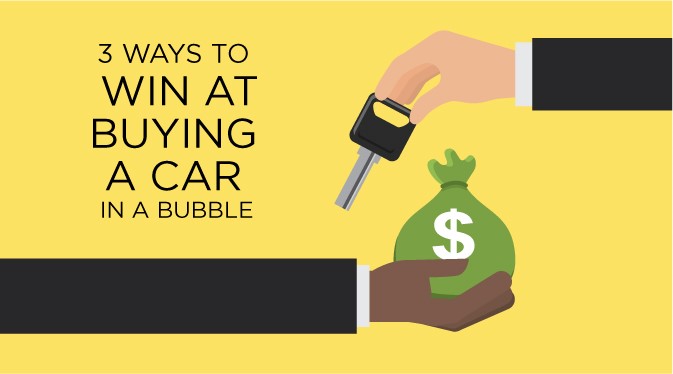With public transit, private taxi services like Uber, walking, biking and more, buying a car is one option in a myriad of transportation possibilities. However, most people find that at one time or another in their lives, buying a car makes the most sense for their needs. Unfortunately, the average car buyer will lose up to $10k through interest, missed incentives, and poor negotiation that they could have recovered with some research, education, and preparation. Car purchases have a stigma for being a necessary expense. Our 3-step checklist can help you win at buying a car—we even dare to call it an investment. It’s absolutely possible.
Before we dive in, let’s take a quick look at the economics of the auto industry in America today that will help us understand car buying. Most auto loans are positioned the same was as a mortgage; consumer to bank. The bank then sells the loan to an investment bank. Currently, we’re seeing that Americans have more than $1.2 trillion dollars of debt for auto loans and 25% of these loans are subprime (a credit score of 600 or less and an interest rate over 10%). Subprime loans are a bigger default risk than prime loans.
We’ve talked before about the Student Loan bubble. It’s a situation where loans are easy to get, and if a large number of people simultaneously default on those loans, that bubble bursts—see our blog How to Stop the Student Loan Crisis from Killing Your Retirement Savings. Yes, you guessed it—a bubble is also forming in the auto industry, and if we see a tidal wave of defaults, that bubble will burst. When it bursts, auto prices (as well as the value of your current car) will dive, and we’ll all be affected either directly, through the market, or through the recovery process as taxpayers. If you happen to be buying a car now, a little research and effort can help you stay in a good place with your auto transactions.
When it comes to car buying we want you to do three things:
- Set your budget
- Select three cars
- Negotiate with the dealer or private seller
Set Your Budget
Qualifying for a $25,000 car doesn’t necessarily mean that is your car budget, but finding out your credit score and how much you would qualify for is a good first step if you’re not planning to pay cash. Remember, you can pay for a car three different ways; cash (or bringing cash to the table by getting your own loan), dealer finance, or lease.
After you’ve researched your financial situation and your possibilities for paying for the car, assess how you will use your car and determine you needs versus your wants. When you say you “need” a leather-wrapped steering wheel, what you actually need is a reality check. Here’s just one example:
| Needs | Wants |
| Seating capacity | Leather |
| Fuel economy | Heated seats |
| Safety features (like all-wheel drive) | Electric seat memory |
| Reliability and low maintenance | Entertainment system |
| Cruise control | WiFi |
Also, if you have a trade-in, this is the time to find out the value. Go online to Kelley Bluebook, NADA, or Edmond’s. The key is to enter as much detail as possible to get an accurate value for both selling to a private party and trading your car in at a dealership.
Select Three Cars
Next, you’ll select three different cars. You want to find three viable options that are different styles and different makers. Even if you really prefer one car over the others, researching this gives you comparison, leverage, and takes some of the emotion out of your decision.
Use online resources and get email quotes from dealers. For new cars, they may give you an MSRP (Manufacturer’s Suggested Retail Price). Remember that number is still negotiable. The dealership received incentives from the manufacturer that allow that price to go down even more.
Next, consider ongoing cost of ownership for your car choices. Ask yourself if, say, an Accord is a cheaper car to own than a Camry. Ongoing maintenance, repairs, and insurance can influence your choices.
Negotiate With the Dealer or Private Seller
Lastly, you’ll test drive the cars and negotiate a deal. Negotiating with a private seller has its advantages and disadvantages. You’re negotiating with a person instead of an entire car company, commission isn’t involved, and typically they are not professional negotiators. Though most of them are just like you; honest, fair, and reasonable, they need to get rid of the car for a reason and may not be forthright with why.
Suppose you’re going to a dealership. Most car salespeople are well-intended, despite their perpetuated reputation. They are taught to sell cars, but are you taught to buy cars? No. Most of us haven’t really honed negation skills, because we are used to paying a set price for consumer goods. That puts the sales person at an advantage right away, and it also puts customers on their guard—that’s an awkward way to start a negotiating relationship.
If you are prepared and educated, you can come in with a friendly, knowledgeable attitude. The dealer will likely appreciate this and adjust the sales pitch, and you will feel more in control of the situation. You don’t need the upper hand, just an even playing field.
When you’re negotiating, stay focused on the total price of the vehicle. Don’t get caught up in the monthly payment price. That’s a key tactic to wiggle you into something more expensive that you’ll be paying for longer. You’ll find yourself stuck in a car, because you owe more than it is worth and your monthly payment could last for up to 7 years.
Pro tips:
- Only buy a new car when you know that markdowns, incentives, and ongoing resale value benefit you.
- Research how the time of month or year affects your negotiation. Car dealers often have end-of-month incentives or they may be trying to push out last year’s model.
- Never get a loan at subprime (over 10% interest). It’s the quickest way to get upside down and owe more than your car is worth.
- Study and work with depreciation. Generally speaking, the greatest depreciation happens after you drive it 10k, 20k, or 30k miles.
- If you are buying a used car, get the CARFAX® report. Has the car been in an accident? Make sure the title is clean.
Whether you are buying a new or used car, or buying from a dealer or private party, the three steps are the same. When you research, learn, prepare, and negotiate while buying a car, you win. We consistently encourage you to educate yourself. When you calculate the expense and possible lost-opportunity costs, the way you buy cars can hugely affect your financial strategy for good or bad.
There’s one more option for financing a car that we haven’t talked about, that’s being your own bank and taking a loan from your permanent life insurance policy. If you go this route, you’ll save even more on that car purchase. We’ve create a FREE, extensive eCourse called Infinite 101® that will show you how that’s done. It only takes 2 minutes to sign up and you’ll receive access to video tutorials, articles, and podcasts. It literally costs you nothing to become educated on this and other amazing financial strategies!
Take advantage of this FREE resource by clicking below.


FAQ
Q: What are the three strategies for buying a car in a current market bubble?
A: The strategies include setting a realistic budget, selecting three different cars for comparison, and effectively negotiating with the dealer or private seller.
Q: How can setting a budget assist in car buying?
A: Setting a budget helps in understanding financial limits and assessing needs versus wants, which is crucial for making a financially sound decision.
Q: Why is it important to select three different cars when buying?
A: Selecting three different cars provides comparison and leverage, helping to remove emotion from the decision and ensuring a better deal.







